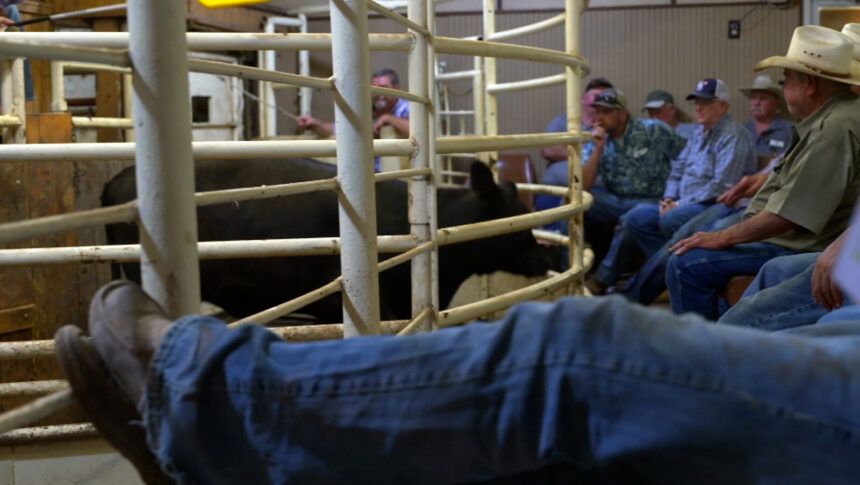‘Something’s gotta give.’ Relentless heat and worsening drought conditions are devastating Texas cattle ranchers

Buyers and sellers attend a livestock auction in Seguin
By Ed Lavandera and Ashley Killough, CNN
It’s a hot July day and a horse rolls around in a patch of dust on Wade Maierhofer’s farm in central Texas. A year ago, that same sandy spot was buried under 8 feet of water — a drinking pond for the rancher’s cattle in normal times.
But the pond has since shriveled to a thin layer of algae and sand surrounded by acres of crunchy, dead land. Widespread drought and scorching temperatures are stripping Texas — and other parts of the country — of vital water and lush fields needed to sustain livestock.
“The heat has been just relentless,” Maierhofer says as he gazes out across the now dry water hole on his property in Seguin. “That’s what’s baked our pastures and turned everything brown.”
Seguin is in Guadalupe County, which is experiencing its second driest year to date of the past 128 years, according to the National Integrated Drought Information System.
This part of Texas averages 24 to 48 inches in precipitation annually, according to the Texas Water Development Board. Measurements from the US Geological Survey show Seguin has only received 4 inches of precipitation so far this year.
Maierhofer says he hasn’t seen green grass on his property in four months.
His cattle now have to walk half a mile in triple-digit temperatures to find the next natural source of water. He also pumps in city water to a nearby trough — an alternative that’s way more expensive than the free reservoir he usually gets from his pond.
The worsening conditions are making it so difficult to maintain healthy cattle that ranchers are selling off cows at a startling pace not seen in more than a decade, foreshadowing troubling trends for consumer prices. With so many cows sold and slaughtered at once, fewer calves will be born next year, which means less beef on the market down the road.
‘Some people are throwing their hands in’
At an auction barn called the Seguin Cattle Company, truck after truck dropped off cows for an auction on Wednesday. One rancher was teary-eyed as he watched his cattle step off the trailer and be herded into pens.
Bryan Luensmann, who manages the auction company, said it can be painful for ranchers who’ve worked years to build herds to now have to sell off so soon.
“When Mother Nature’s slamming you like this, I mean, whether it’s feed for the cattle or running out of water, something’s gotta give and you got to let some of them go,” he said. “At the end of the day, people rely on this as an income.”
The auction barn typically doesn’t get busy until late fall, but Luensmann said this year, it’s been active all summer as ranchers try to lighten their load to save the rest of their herds.
“It’s gonna continue this way until it rains, or we sell off the last of the cattle around here,” he said.
On top of drought conditions, ranchers are also grappling with inflation.
The cost of vehicles, equipment and diesel has skyrocketed, making it financially impossible for many to stay afloat.
“That’s why some people are throwing their hands in,” Luensmann said.
Amador Guerrero of nearby La Vernia, Texas, has been raising cattle as a hobby since high school.
A calf would normally bring in $400 to $800 at auction, he said. On Wednesday, he watched his calf sell for $70.
With so many ranchers selling off cattle, the market is flooded and the price for cows has gone down.
Along with his calf, he also sold an older cow on Wednesday, which he said would normally sell for $300 to $900. Guerrero, standing outside of the auction, said he didn’t want to know the price at which his cow was sold.
“I don’t even want to look,” he said.
Maierhofer sold 20 of his cows last week, but he’s trying to hang on to a hundred others as he hopes for rain by the end of the year. It will cost him greatly to keep them at a healthy weight, but he said he’s willing to take the risk.
The hay that he grows for his cattle and sells to other ranchers has also dramatically dwindled. Last year, he made 4,000 bales of hay. This year, he’s made less than 300.
“If the drought breaks before the first of the year, we’ll just look back and say it was really tough,” Maierhofer said. “And if it doesn’t, we’ll remember it, because we’ll have to sell (the herd), and then we’ll have to wait until it rains and start over again.”
“It’s uncomfortable to spend this kind of money,” he said. “But you know what, if you take care of a cow, she’ll take care of you.”
The-CNN-Wire
™ & © 2022 Cable News Network, Inc., a WarnerMedia Company. All rights reserved.
CNN’s Stephanie Becker contributed to this report.

